Archeological approach to shamanic artefacts – especially jewelry
Shamanism is a belief system, similar to many modern day religions and possibly linked to magic, medicine and healing. During the 1950’s shamanism became a popular way to explain the secrets of obscure European ritual objects and practices, ancient myths or legends common in most hunter-gatherer societies. The word shaman comes from the Evenk (Tungusic) word “šamán”, from Northern Asia and means “he/she who knows“. David Lewis-Williams is often credited with generating interest in shamanism among prehistorians. Following his studies of Drakensberg rock art in South Africa, in the context with the local San people (hunter-gatherers) rituals, led him to the conclusion that prehistoric rock art was created from the visions of shamans in various states of trance induced by ritual dance, sensory deprivation or the ingestion of hallucinogen.
In the case of shamanic performance, shaman requires props that would have included paraphernalia associated with status and rank of the shaman, such as body adornment – which includes: dress, jewelry, body paint, body scaring, tattooing. Although some of these paraphernalia are intangible, we have indications how their jewelry – amulets or talismans may look like.
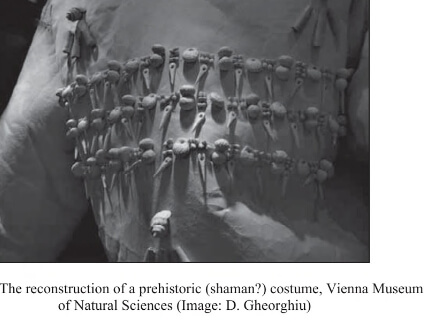
A tiny 11,000-year-old pendant found at a famed prehistoric site in North Yorkshire – Scarborough is the earliest known Mesolithic art in Britain and could have belonged to a shaman. Crafted from a single piece into a three-millimeter thick shale containing outlines of a tree, a map, a leaf or tally marks. The possibility that the pendant belonged to a shaman is likely because headdresses made out of red deer antlers found nearby (Star Carr) in earlier excavations are thought to have been worn by shamans.
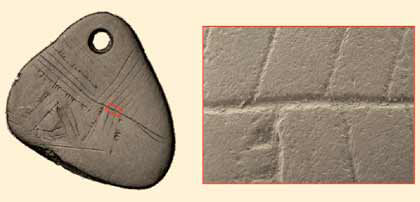
A rich set of grave-goods were found in one of three burials excavated during 1930’s at Bad Dürrenberg (Saalekreis district, Saxony-Anhalt, Germany). This was the grave of a 25-35 year-old female buried between 9,000-6,000 years ago, along with a 6-12 month-old child. The grave was filled of red hematite, which was at least 30 cm deep.
A variety of objects were found with her in the grave (now on display at the Landesamt für Denkmalpflege und Archäologie Sachsen-Anhalt). These have not been interpreted merely as food supplies for the beyond – grave goods included: several flint blades, two bone needles, roe deer (Capreolus capreolus) antler, 16 red deer (Cervus elaphus) incisors, polished stone celt, wild boar (Sus scrofa) tusks, various bones (crane, beaver, red deer), shell fragments from swamp turtles (pseudemydura umbrina) and 120 fragments of freshwater mussels.
Renewed examination of the skeleton revealed a deformity in the first neck vertebra, which could have caused lameness and difficulties in movement. Therefore, it can be presumed that it was an alleviation for the woman to be in trance. Ethnographic parallels suggest that many of these bones and objects may be explained as items used in ritualistic / shamanistic practices.
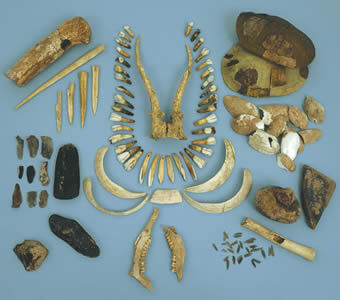
An unusual early Bronze Age (1900-1700 BC) grave of a male who may also have been a goldsmith, was discovered in a 12m diameter round barrow, known as G2a at Upton Lovell in Wiltshire. The grave was on a ridge that overlooked the valley leading towards Stonehenge.
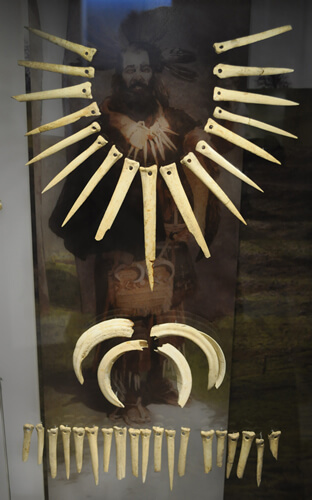
The barrow was first opened in 1801 by William Cunnington who found two skeletons (rumored to be man and wife) and numerous grave goods, including a dark battle axe head made of dolerite from Northumberland, perforated bone, boar tusks, a jet ring and jet necklace, flint and other stones. There was also four cups made from split flint nodules and a bronze point, possibly used for tattooing.
One theory by Piggott (1962) is that the male was buried in a cloak of skin or fur that had 36 bone points sewn into the lower hem, probably making the garment rattle as he moved. More bone points where arranged around his chest, possibly in a necklace and four pierced boar’s tusks found by his knees may have decorated a pouch.
At his feet was a collection of stones, which were possibly a set of metalworker’s hammers and grinding stones, indicating that he may have been a goldsmith.
Across all of Europe the marine mollusc known as the thorny oyster was used to make the most prized ornaments of the Neolithic period. Major centres for the collection of these shells and the fabrication of the valued ornaments were located on the Istrian coast. Thus the Istrian seaboard became one of the points of departure for humanity’s first great luxury products exchange network, emerging parallel to the advent of agriculture, and marking the dawn of the new economic order that emerged during the Neolithic period.
The thorny oyster is better known by its Latin name Spondylus (Spondylus gaederopus). Today it is known only to a small number of shell enthusiasts. 7,500 years ago, however, at the beginning of the Middle Neolithic, these shells were used for the fabrication of beads, bracelets, pendants and belt sets – an entire range, in fact, of very popular ornamental objects found across all of the European continent. Many researchers believe that Spondylus jewellery was a mark of wealth and prestige, and a large number maintain that Neolithic shamans used them as ritual objects.
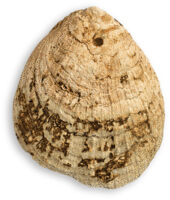
Spondylus shell with traces of working Origin (made): Kargadur, Middle Neolithic Location (collection): Archaeological Museum of Istria, Pula
Thus, having in mind these few examples of jewelry artefacts which give us some space to consider them as shamanistic paraphernalia – it is noticeable that probable necklaces were made of natural materials: bone, shells, stone and each material has proper meaning and value in ritualistic practices.
Some materials used in shamanic practice or as jewelry by shamans are degradable but we try to reconnect with the past and revive even the colors in our collection of contemporary shamanic necklaces.
